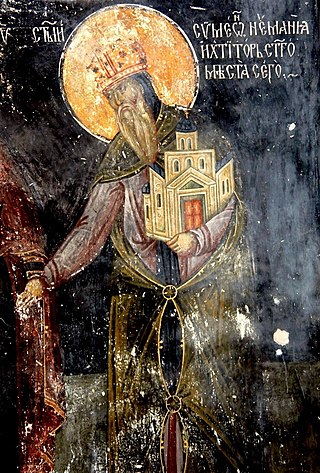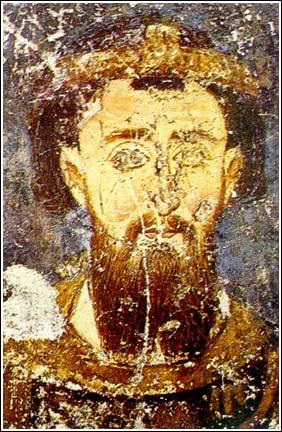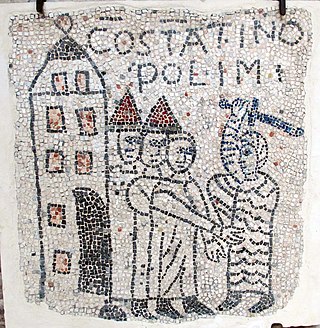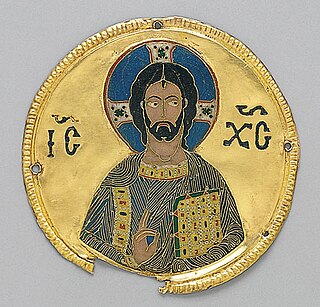
The Fourth Crusade (1202–1204) was a Latin Christian armed expedition called by Pope Innocent III. The stated intent of the expedition was to recapture the Muslim-controlled city of Jerusalem, by first defeating the powerful Egyptian Ayyubid Sultanate. However, a sequence of economic and political events culminated in the Crusader army's 1202 siege of Zara and the 1204 sack of Constantinople, rather than the conquest of Egypt as originally planned. This led to the Partitio terrarum imperii Romaniae or the partition of the Byzantine Empire by the Crusaders and their Venetian allies leading to a period known as Frankokratia, or "Rule of the Franks" in Greek.

The Latin Empire, also referred to as the Latin Empire of Constantinople, was a feudal Crusader state founded by the leaders of the Fourth Crusade on lands captured from the Byzantine Empire. The Latin Empire was intended to replace the Byzantine Empire as the Western-recognized Roman Empire in the east, with a Catholic emperor enthroned in place of the Eastern Orthodox Roman emperors. The main objective of the Latin Empire was planned by Venice, which promoted the creation of this state for their self-benefit.

The Latin Patriarchate of Constantinople was an office established as a result of the Fourth Crusade and its conquest of Constantinople in 1204. It was a Roman Catholic replacement for the Eastern Orthodox Ecumenical Patriarchate of Constantinople and remained in the city until the reconquest of Constantinople by the Byzantines in 1261, whereupon it became a titular see. The office was abolished in 1964.

The Ecumenical Patriarchate of Constantinople is one of the fifteen to seventeen autocephalous churches that together compose the Eastern Orthodox Church. It is headed by the Ecumenical Patriarch of Constantinople.

Stefan Nemanja was the Grand Prince of the Serbian Grand Principality from 1166 to 1196. A member of the Vukanović dynasty, Nemanja founded the Nemanjić dynasty, and is remembered for his contributions to Serbian culture and history, founding what would evolve into the Serbian Empire, as well as the national church. According to the Serbian Academy of Sciences and Arts, Nemanja is also among the most remarkable Serbs for his literary contributions and altruistic attributes.

Stefan Nemanjić, known as Stefan the First-Crowned, was the Grand Prince of Serbia from 1196 and the King of Serbia from 1217 until his death in 1228. He was the first Serbian king by Nemanjić dynasty; due to his transformation of the Serbian Grand Principality into the Kingdom of Serbia and the assistance he provided his brother Saint Sava in establishing the Serbian Orthodox Church.

The House of Nemanjić was the most prominent dynasty of Serbia in the Middle Ages. This princely, royal and imperial house produced twelve Serbian monarchs, who ruled between 1166 and 1371.
The East–West Schism, also known as the Great Schism or the Schism of 1054, is the break of communion between the Catholic and Eastern Orthodox churches since 1054. A series of ecclesiastical differences and theological disputes between the Greek East and Latin West preceded the formal split that occurred in 1054. Prominent among these were the procession of the Holy Spirit (Filioque), whether leavened or unleavened bread should be used in the Eucharist, iconoclasm, the coronation of Charlemagne as Emperor of the Romans in 800, the Pope's claim to universal jurisdiction, and the place of the See of Constantinople in relation to the pentarchy.

The Catholic Church in Greece is part of the worldwide Catholic Church, under the spiritual leadership of the Pope in Rome. Indigenous Roman Catholic Greeks numbered about 50,000-70,000 in 2022 and were a religious and not an ethnic minority. Most of them are a remnant of Venetian and Genoese rule in southern Greece and many Greek islands from the early 13th until the late 18th century, Greeks who converted to Catholicism or descendants of the thousands of Bavarians that came to Greece in the 1830s as soldiers and civil administrators, accompanying King Otto. One very old but still common term to reference to them is Φράγκοι, or "Franks", dating to the times of the Byzantine Empire, when medieval Greeks would use that term to describe all Catholics.
The history of the Eastern Orthodox Church is the formation, events, and transformation of the Eastern Orthodox Church through time. According to the Eastern Orthodox tradition, the history of the Eastern Orthodox Church is traced back to Jesus Christ and the Apostles. The Apostles appointed successors, known as bishops, and they in turn appointed other bishops in a process known as Apostolic succession. Over time, five Patriarchates were established to organize the Christian world, and four of these ancient patriarchates remain Orthodox today. Orthodox Christianity reached its present form in late antiquity, when the ecumenical councils were held, doctrinal disputes were resolved, the Fathers of the Church lived and wrote, and Orthodox worship practices settled into their permanent form.

This history of the Byzantine Empire covers the history of the Eastern Roman Empire from late antiquity until the Fall of Constantinople in 1453 AD. Several events from the 4th to 6th centuries mark the transitional period during which the Roman Empire's east and west divided. In 285, the emperor Diocletian partitioned the Roman Empire's administration into eastern and western halves. Between 324 and 330, Constantine I transferred the main capital from Rome to Byzantium, later known as Constantinople and Nova Roma. Under Theodosius I, Christianity became the Empire's official state religion and others such as Roman polytheism were proscribed. Finally, under the reign of Heraclius, the Empire's military and administration were restructured and adopted Greek for official use instead of Latin. Although the Roman state continued, some historians choose to distinguish the Byzantine Empire from the earlier Roman Empire due to the imperial seat moving from Rome to Byzantium, the Empire’s integration of Christianity, and the predominance of Greek instead of Latin.

The sack of Constantinople occurred in April 1204 and marked the culmination of the Fourth Crusade. Crusader armies captured, looted, and destroyed parts of Constantinople, then the capital of the Byzantine Empire. After the capture of the city, the Latin Empire was established and Baldwin of Flanders was crowned Emperor Baldwin I of Constantinople in the Hagia Sophia.
The East–West Schism that occurred in 1054 represents one of the most significant events in the history of Christianity. It includes various events and processes that led to the schism and also those events and processes that occurred as a result of the schism. Eastern and Western Christians had a history of differences and disagreements, some dating back to the period of Early Christianity. At the very root of what later became the Great Schism were several questions of pneumatology and ecclesiology. The most important theological difference occurred over various questions regarding the procession of the Holy Spirit, and the use of the filioque clause in the Nicene Creed. One of the main ecclesiological issues was the question of papal supremacy. Other points of difference were related to various liturgical, ritual, and disciplinary customs and practices. Some political and cultural processes also contributed to the breakout of the schism.

The Massacre of the Latins was a large-scale massacre of the Roman Catholic inhabitants of Constantinople, the capital of the Eastern Roman Empire, by the Eastern Orthodox population of the city in April 1182.

Christianity in the 11th century is marked primarily by the Great Schism of the Church, which formally divided the State church of the Roman Empire into Eastern (Greek) and Western (Latin) branches.

The 14th century saw major developments in Christianity, including the Western Schism, the decline of the Crusades, and the appearance of precursors to Protestantism.

Christianity in the Middle Ages covers the history of Christianity from the fall of the Western Roman Empire. The end of the period is variously defined. Depending on the context, events such as the conquest of Constantinople by the Ottoman Empire in 1453, Christopher Columbus's first voyage to the Americas in 1492, or the Protestant Reformation in 1517 are sometimes used.

Saint Sava, known as the Enlightener, was a Serbian prince and Orthodox monk, the first Archbishop of the autocephalous Serbian Church, the founder of Serbian law, and a diplomat. Sava, born as Rastko Nemanjić, was the youngest son of Serbian Grand Prince Stefan Nemanja, and ruled the appanage of Zachlumia briefly in 1190–92. He then left for Mount Athos, where he became a monk with the name Sava (Sabbas). At Athos he established the monastery of Hilandar, which became one of the most important cultural and religious centres of the Serbian people. In 1219 the Patriarchate exiled in Nicea recognized him as the first Serbian Archbishop, and in the same year he authored the oldest known constitution of Serbia, the Zakonopravilo nomocanon, thus securing full religious and political independence. Sava is regarded as the founder of Serbian medieval literature.
This is a timeline of the presence of Eastern Orthodoxy in Greece from 717 to 1204. The history of Greece traditionally encompasses the study of the Greek people, the areas they ruled historically, as well as the territory now composing the modern state of Greece.
This is a timeline of the presence of Eastern Orthodoxy in Greece from 1204 to 1453. The history of Greece traditionally encompasses the study of the Greek people, the areas they ruled historically, as well as the territory now composing the modern state of Greece.



















